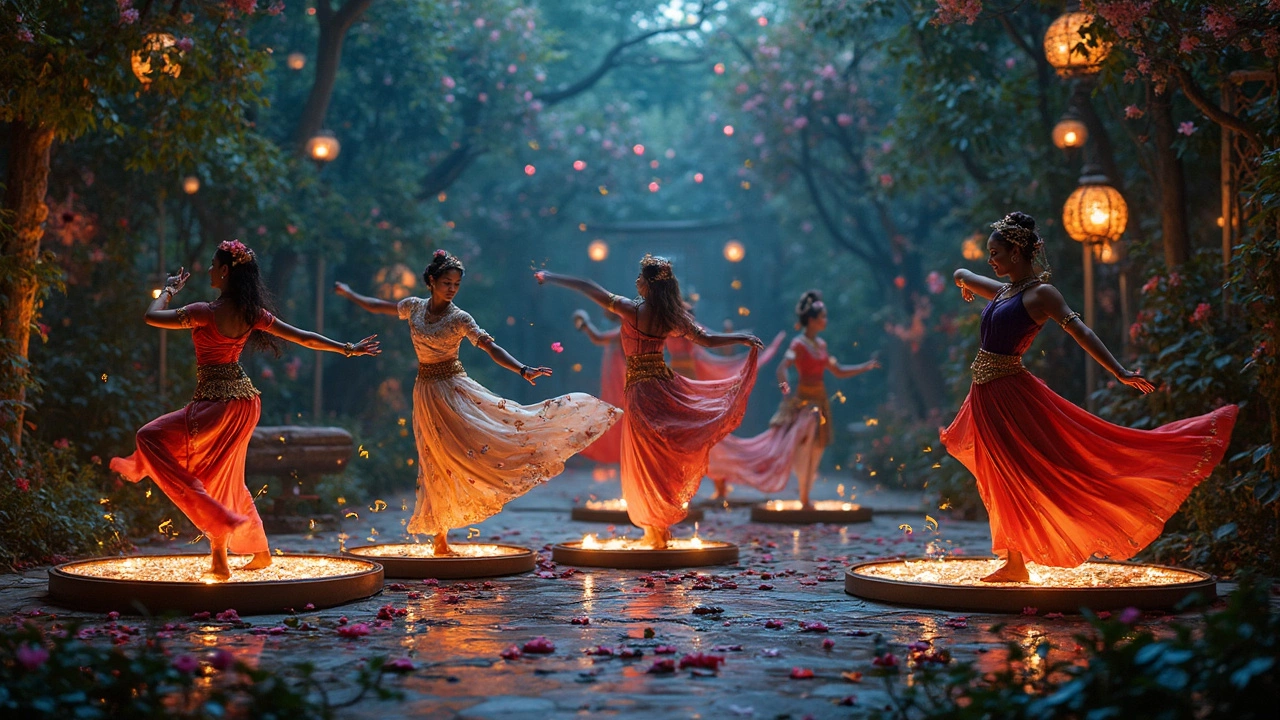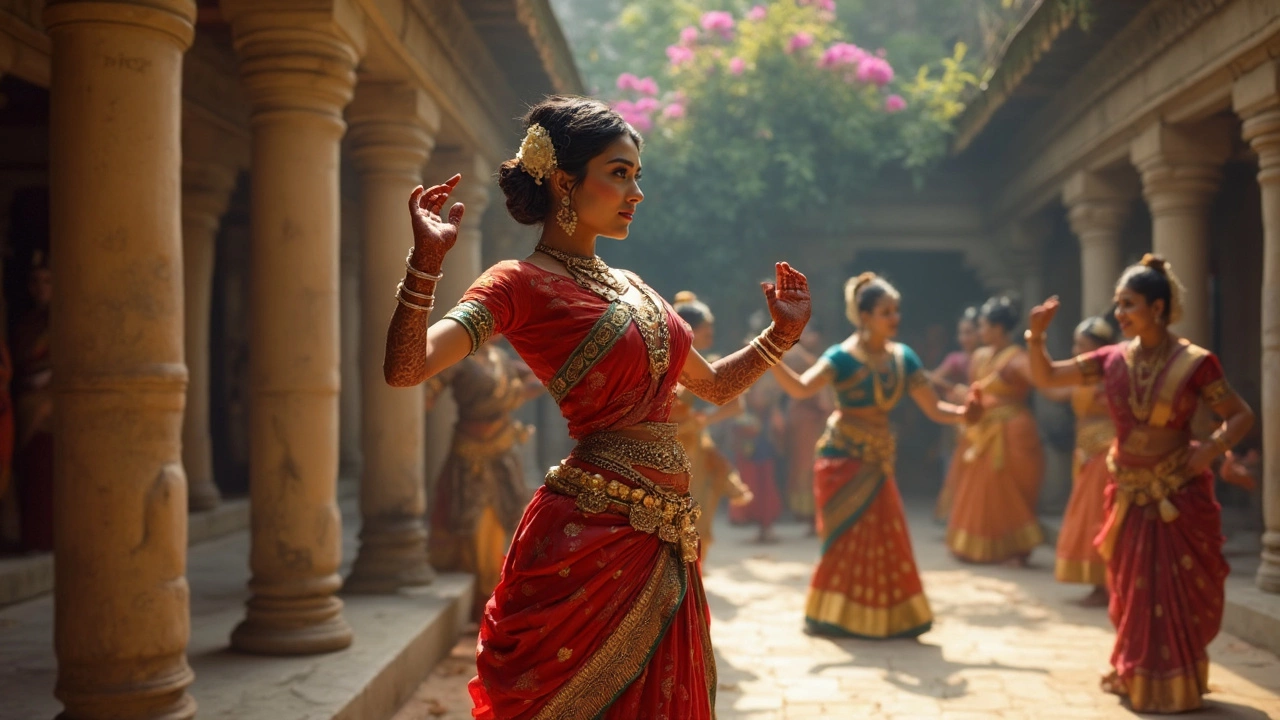When people talk about eastern dance, they usually refer to a collection of dance forms that originate from the Eastern parts of the world, like Asia and the Middle East. These dances are vibrant, full of culture, and come with a heavy dose of tradition. They're not your regular ballads or waltzes; instead, each dance style has its own flavor and backstory that makes it special.
Take Bharatanatyam from India, for example. It's not just dance; it's a whole narrative experience with precise hand movements and footwork. The roots of these dances often go back centuries, mixing religious, social, and cultural elements. It’s like a time capsule you get to watch live.
And here’s something interesting—you'll notice that costumes play a big part in these dances. There's often a lot of meaning tied up in what the dancers wear, from the color to the fabric to the accessories. So, when you're enjoying an eastern dance performance, you're looking at a rich tapestry of history and meaning that’s been passed down through generations.
- Introduction to Eastern Dance
- Historical Roots and Influences
- Popular Styles and Their Unique Features
- Cultural Significance and Symbolism
- Tips for Appreciating and Learning Eastern Dance
Introduction to Eastern Dance
Eastern dance is like stepping into a vibrant world steeped in tradition and culture. This category covers a wide range of regional dances from countries like India, China, Japan, and the Middle East. Unlike Western dance styles, these dances often incorporate storytelling, spirituality, and cultural rituals into their movements.
One cool thing about eastern dance is its diversity. While some forms like the Indian Bharatanatyam are all about precise movements and telling stories through hand gestures, others like Chinese classical dance focus on fluidity and grace. Each style has its own unique charm.
According to a study by the Cultural Heritage Institute, "Eastern dances are not merely performances but are considered living traditions that offer insights into the identities and values of the cultures from which they emerge."
The dance does not tell the story straight; it tells the story with mystery, rhythm, and color, drawing the audience into its spellbinding world." - Cultural Heritage Institute
The Roots of Eastern Dance
These dance forms date back centuries and have evolved over time. They're often linked with religious rituals and communal gatherings. For instance, many eastern dances are performed during festivals or important ceremonies, adding a layer of meaning to their expression.
What Makes Eastern Dance Special?
Things like costumes and music make a huge difference. Each element contributes to the overall vibe of the performance. And here's a tip—keep an eye out for how these dancers use facial expressions. It’s a critical part of conveying the narrative.
Historical Roots and Influences
When we dive into the historical roots of eastern dance, it's like opening a treasure chest of stories, legends, and deep culture. Many of these dances have their origins in religious and spiritual rituals. In India, for instance, dances like Bharatanatyam and Kathak were initially performed in temples as a form of worship and storytelling, passing on epic tales from the Ramayana and Mahabharata through intricate movements and expressions.
The influence of trade routes and migrations can't be ignored either. Look at the Chinese classical dance; it's a mesh of moves that has been shaped over thousands of years influenced by folklore and historical events. The Silk Road brought in a blend of styles from Persia to Central Asia, enriching the dance forms we see today.
If you're curious about the Middle Eastern dance, think about belly dancing. This dance goes way back, with its roots linked to ancient goddess worship and fertility rites. It's fascinating how these moves, once sacred, have evolved into entertainment and artistic expression world over.
Influence of Historical Periods
Different historical periods left their mark on these dance styles. During the Mughal era in India, dance forms like Kathak experienced a transformation, merging Persian themes and styles into its core. Meanwhile, in China, various dynasties such as the Tang and Han were influential in shaping the dance forms, often reflecting the country's socio-political climate.
Even in Japan, the traditional dance-drama, Kabuki, reflects the Edo period's influence, bringing in themes of urbanization, social issues, and transformations of city life, all delivered with dynamic expression and dramatic costumes.
Time has added layers to these dances, making them complex yet fascinating to explore. So, whenever you watch or try to learn an eastern dance, remember you’re engaging with history itself.

Popular Styles and Their Unique Features
When diving into the world of eastern dance, it's easy to get lost in a sea of styles, each with its own personality. Let's break a few popular ones down and see what makes them tick.
Bharatanatyam
Bharatanatyam hails from India and is one of the oldest dance forms in the world. The style is all about storytelling—dancers use intricate footwork, hand gestures (mudras), and facial expressions to convey tales from Hindu mythology. Originally a temple dance, Bharatanatyam is a reflection of spirituality and devotion.
Chinese Classical Dance
Chinese classical dance isn’t just about elegant movements; it incorporates acrobatics and strength. Dancers wear flowing costumes that enhance the mesmerizing spins and leaps. This style is rich with symbolism, often depicting historical or mythical stories from ancient China.
Flamenco
Flamenco, although rooted in Spain, has strong Eastern influences due to Moorish and Indian connections. It's famous for its emotional intensity, lightning-fast footwork, and the use of props like fans or hats. The dance is usually accompanied by guitar and singing, making it a full-fledged sensory experience.
Belly Dance
Belly dance is most recognized for its shimmies and undulating movements. It's a dance that deeply connects dancers to music, using body isolation to interpret the rhythms. Although often linked to the Middle East, its roots spread across various eastern regions.
Kabuki
This Japanese dance-drama is known for its elaborate costumes and exaggerated actions. Kabuki combines music, dance, and mime into a captivating performance style. It paints a vivid picture of historical tales, often infused with mythical elements.
Here's a quick comparison of some features:
| Dance Style | Region | Key Feature |
|---|---|---|
| Bharatanatyam | India | Storytelling through mudras |
| Chinese Classical Dance | China | Acrobatics and grace |
| Flamenco | Spain (Eastern Influence) | Emotional expression |
| Belly Dance | Middle East | Body isolation |
No matter which regional dances you explore, each presents a unique glimpse into the culture and history of its origins. It's a fantastic way to travel the world without leaving your seat!
Cultural Significance and Symbolism
Now, let's dive into the heart and soul of eastern dance—its cultural significance and symbolism. These dances are not just about fancy footwork and stunning costumes; they’re a living history book.
The Storytelling Element
In many regional dances, every movement tells a story. For instance, in Indian classical dance forms, mudras or hand gestures are packed with meaning. A simple motion can depict a concept, an element, or one of the many Hindu deities. The storytelling is not only in the choreography but also in facial expressions, which bring emotions to life.
Spiritual and Religious Roots
Religion plays a big role too. In Bali’s traditional dances, performances often happen during temple ceremonies, blending entertainment with spiritual devotion. The dancers are not just performers; they’re participants in a sacred ritual that’s as important today as it was centuries ago.
- Chinese classical dance often incorporates elements of martial arts, showing off harmony and balance.
- Many Middle Eastern dances, like belly dance, are deeply tied to ancient celebrations and community rituals.
Representation of Society
Dance in these regions can act like a social mirror that reflects societal norms. The graceful movements of Japan’s Noh and Kabuki tell tales of historical events and even comment on social issues of the time.
These dances have a huge cultural impact and governments, as well as local institutions, often invest in preserving these traditions, organizing festivals and workshops to keep them alive. For example, in 2020, UNESCO estimated that cultural activities, including traditional dance, contributed billions to the Asian economy.
So, next time you watch an eastern dance, remember that what you're seeing is more than just a performance—it's a vibrant piece of cultural history that's still evolving today.

Tips for Appreciating and Learning Eastern Dance
If you're looking to really get into eastern dance, there are plenty of ways to dive deeper and truly appreciate these beautiful art forms. It’s all about understanding and engaging with the culture behind it.
Watch Performances
The best way to start is by watching live performances or online videos. Check out cultural festivals in your area, as they often showcase traditional regional dances from various countries. YouTube is another great resource for countless videos, complete with explanations of what each part of the dance signifies.
Learn the Basics
You don’t need to become a professional dancer, but learning a few basic steps could help you connect better with the dance. Look for local classes or online tutorials that can give you a feel for the footwork and hand movements, especially in styles like Bharatanatyam or Chinese classical dance.
Understand the Cultural Context
Each dance tells a story, often rooted in history or mythology. Reading up on the cultural significance of the dance can enrich your understanding. Whether it's a tale of deities in Indian dance or historical events represented in Middle Eastern dances, each step is meaningful.
Pay Attention to Details
Costumes and music are integral to these performances. Notice the colors, fabrics, and accessories. These details often carry meanings, like red for passion or devotion in some Asian dances.
Join Community Events
Join dance workshops or community events where you can interact with enthusiasts and experts. This can also give you a sense of the energy and atmosphere that's hard to capture through a screen.
Statistics on Cultural Engagement
| Region | Popularity of Dance as Cultural Engagement |
|---|---|
| Asia | 78% |
| Middle East | 65% |
According to recent data, over 70% of people engaging with cultural events in Asia choose traditional dance as a way to connect with heritage, highlighting the importance of dance in cultural identity.
